#polyp stage
Explore tagged Tumblr posts
Note
2 shrimps down 13 more to go! Runner and Aid you guys have quite the work cut out for you! Go big or go home sjhsjsj
i mean...

the man might have backed out a wee bit
#spot says stuff#rw#oc tag#hi!! hello hi!!!!! lookie here i talk in tags a lot!!!!!!!! i recommend checkin those out gjldscmlkds ← not meant to be mockin or anythin#overall though yeah ancients have easier time carrying kids than slugcats n then you add in the twos size difference when they are-#-the runner and the aid and you get a ''okay maybe we should Think about this actually''#slugs prolly give live birth while my ancients just kinda pop some eggs out n not every makes it to the polyp stage n so only one survivor-#-remains from the litter. but easier time gettin the babies out of the carrier body
12 notes
·
View notes
Note
crying because thinking about how muscular would react after knowing that his cannibal husband got killed by the heroes
you assume, incorrectly, that moonfish is capable of dying
#he’s functionally immortal to me ❤️#he reverts into polyp stage and goes thru a new life cycle#like that one species of jellyfish#swolefish#moonfish#muscular#bnha#mha#goot#jasks#(jay’s asks)
4 notes
·
View notes
Text
I thought fern life cycles were weird but jellyfish life cycles literally blow them away in terms of sheer what-the-fuckery
1 note
·
View note
Text
Look I'm sorry to anyone who thought the Saja Boys were a real band, but it was obviously fake from the beginning.
Huntr/x has been doing this gimmick for years where they'll put on a performance and some actors dressed up like demons will "interrupt" it or get into some choreo fights on stage and stuff. If you're a fan you know, the demons usually symbolize things like industry corruption, Mira's struggle with her family, Rumi being in the closet, etc, and there's lots of hints and secret messages to the fans in what they're wearing or how they show up. Check out huntresx5evah on blsky they've got an extensive examination of the "demons" over the years and what the messages to the fans are.
In the concert before Golden was released, the demons were dressed like flight attendants. That was the indication that something new was about to take off. @/queenhuntrixdontmiss and I speculated that it was going to be a new single and low and behold, it was.
But then the live performance got cancelled. It's an open secret that Rumi was having vocal issues, so that was probably not planned. They needed to buy time for her to recover, so, enter the Saja Boys -- a fake band of guys really clearly pretending to be demons, they release ONE single, do a bunch of b-tier variety shows for a week, nearly all of their public appearances have Huntr/x right there, keeping the hype and energy up until Rumi can get her throat polyps removed and furthering the routine where Huntr/x are supposed to be secret demon hunters and the Saja Boys are supposed to be secret demons.
Then the whole thing culminates in the Golden live performance at the idol awards, the big act with Huntr/x fake "break up" and the subsequent theatrics to make it up to fans for failing the first Golden performance. Huntr/x takes their obligation to fans very seriously, I've no doubt that they all felt terrible about having to cancel, so a free show was the obvious recourse to try and make it up to people. And they pulled out all the stops!
But the Saja Boys were never real. I mean they got real guys to pretend to be a boy band and do the dancing and lip syncing obviously, but come on, most of them didn't even have names.
1K notes
·
View notes
Text
Jellies are trending 🙌🏼
Everyone is familiar with the basic idea of a jellyfish, but what do we mean when we use that term? Jellies in the class Scyphozoa include most of the species that people think of when hearing the word “jellyfish.” Their life cycles typically include a polyp stage, attached to the bottom, that produces baby medusae. When conditions are right, these babies can grow up to form vast blooms of adult jellies. These "true jellies" are commonly studied at the sea surface, but those living deep in the water column are less well known. Some deep-sea jellies defy what we imagine when we think of jellyfish—some with bells that can stretch up to a meter across, others with no tentacles at all. Many species of swimming jellies are actually in another group called the Hydromedusae. These jellies are often small and transparent, ranging from very few to numerous tentacles. Some Hydromedusans have tentacles that point ahead of them instead of trailing behind them as they swim. These species eat other gelatinous organisms rather than the crustaceans favored by many of their cousins. Even with all this dazzling diversity, we have yet to encounter many of the delicate drifters that live in the deepest waters of our vast ocean.
761 notes
·
View notes
Note
What does the yotici life cycle look like now?
Fairly similar, here's a generalized idea

I Did kind of drop the sessile+asexual polyp mobile+sexual fish alternating generations because it doesn't Really change anything besides sounding vaguely interesting. Fish reproduction is wild enough as-is.
Their eggs are laid in a stringy mass that requires a root to the sea floor (coral, tough kelps, rocks, sticks, etc) and light currents to keep them oxygenated. These egg masses are strong and can bend and sway fairly significantly without coming apart, but will be broken by strong currents and require a sheltered environment to survive. This is the basis of a Garden, an engineered ecosystem designed to protect the eggs, provide substantial and consistent nourishment for the young and resting places and shelter for adults, and additionally function as cultural and social centers.
Larvae are tiny and born with a yolk sac attached to sustain them. They metamorphose into a 'predatory' phase in which they feed on zooplankton and organic debris. These phases are tiny and poor swimmers, wholly reliant on the sheltered environment of the garden for safety and consistent food sources. Those swept out have very little chance of longterm survival. The VAST majority of yotici that hatch at all die in their larval stages.
Most of their anatomy is fully developed as a 'yotling', in which they are much stronger swimmers, school together, and are primarily predatory. Yotlings feed on plankton and other small animals, but their most important food source is their own species' eggs. This is a natural behavior for yotici, and much of the function of the garden is to provide this dependable, clustered food source for their young. The survival benefits of most of their reproductive output being sacrificed to these viable young with a fairly strong chance of survival vastly outweigh the loss, given the vast majority of yotici larvae who hatch to begin with die without ever reaching this phase. Yotlings have much lower mortality rates than the larvae, but a majority will die to predation. They're also frequent bycatch in fisheries and are widely eaten by landdwelling peoples. During the yotling phase, they're about 4-8 inches long.
Their beak starts to develop in the juvenile stage, during which they are 'weaned' out of predatory behavior and start consuming algae and marine plants. They instinctively school around adult yotici and follow them to food sources, usually eating algae that grows around the tougher foods the adults can handle. This tends to be the point in which active parental protection begins, but few yotici cultures conceptualize these juveniles as full people or develop personalized bonds with them, as their mortality rate is still fairly high. During the juvenile phase, they're about 8-14 inches long.
A yotici 'child' has all its base adult anatomy developed, including its tentacles, and looks like a miniature adult. They can eat tougher foods and join the adults in consuming seagrass. This is the point in which they are semi-equivalent to a human infant, rapidly learning and picking up on language and beginning to communicate. Fully active parental care and bonding will occur during this period (the Exact cultural marker of when this starts can vary) and they are conceptualized as people. Diminishingly few yotici actually survive to this phase, but those who do have a very good chance of lasting to adulthood. The child phase starts at about 1-2 ft in length.
At this point they grow steadily until sexual maturity, and will continue to grow (much, much more slowly) throughout the rest of their lives. Sexual maturity takes a VERY long time, usually about 20 years from hatching. An adult yotici generally ranges in size from 12-18 ft, with outstanding or very long lived individuals passing 25 (the World Record would be in the mid 30 ft range). A yotici who survives to reproductive adulthood has excellent chances at a long life, and yotici are by far the longest living sophonts. A lucky individual can crest 200 years.
#Should note that when I make changes for realism it's not because I think worldbuilding should be hyper realistic to be good but because#like. It's fun for me. I like having to think about these things and having to learn and problem solve to conform to Mostly hard#realism. I only drop things when they're not fun for me and/or I like another option better.#And I let a lot of other things be fully unrealistic with like. A little grounding when adjusting for realism would Not be fun for me#Like the three moons is not even slightly realistic (in that it has like no effects whatsoever on this world which is 99.999% earthlike)#but I like it and think it's fun to have the wrinkle of Three Moons and think about how that could affect cultural interpretations of the#moon so I keep it#etc#yotici
127 notes
·
View notes
Text
Phylum Round 3
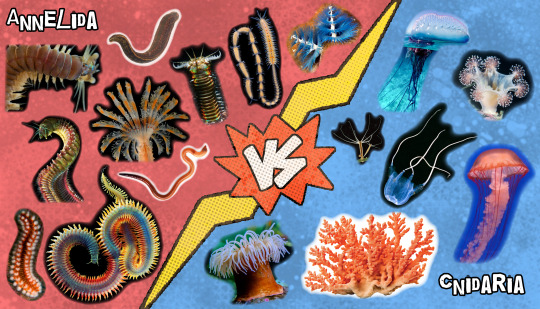
Annelida: Segmented Worms. This group includes earthworms, leeches, and many classes under the umbrella of “polychaete”. This diverse phylum encompasses deposit feeders (eating dirt), detritivores, scavengers, deadly ambush predators, filter feeders, parasites, herbivores, and more. They are broadly defined by their repeating body segments and parapodia, which are nubby appendages used for both movement and breathing. Some have curved jaws for catching prey or scraping detritus off of rocks, while others have wide, elaborate, brightly colored feather-like fans for filter feeding. While able to crawl freely, a majority of marine Annelids spend most of their time in self-built tubes or burrows. Among their many important functions, they play a key role in mixing soil/sediment, breaking down decaying organic matter, and providing a key food source to countless other animals.
Cnidaria: Jellyfish, anemones, corals, box jellies, and hydroids. They have a gelatinous body with radial symmetry, a decentralized nervous system, and tentacles surrounding a simple mouth. The defining feature of this phylum are their cnidocytes, or stinging cells. There are two different body plans of the Cnidaria; an immobile “polyp” attached to a surface, or a free-living “medusa” which can swim or drift in the water column. Many polyp Cnidarians, such as corals, live in colonies. Some corals build reefs which serve as habitat for other animals. Free-living medusa Cnidarians must return to the seafloor in a polyp-like stage as a part of their life cycle.
#annelida#cnidaria#animal bracket#tumblr bracket#bracket tournament#poll bracket#phylum round 3#phylum#begging on my knees for annelids rn sorry I am so biased#world's best most beloved worms
339 notes
·
View notes
Text

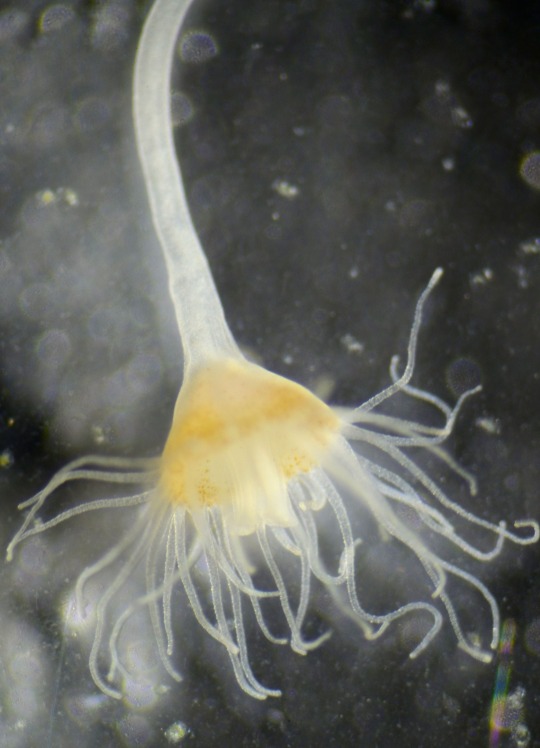
Monomon / Polyp (jellyfish life stage)
244 notes
·
View notes
Text

Pollyanna Philips or "Polyp", the Shamrock Circus' lead costume designer and clown performer.
Pollyanna is a master seamstress and saves the circus quite a bit of money by reparing, replacing and tailoring costumes on the fly. She's also an excellent juggler and clown, preferring the slapstick comedy angle.
An optimist to the core, she truly believes the circus can lead her to greatness and that every setback is temporary. She is nearly always smiling and constantly changing both her act and her look for the stage.
I'm also developing a scary clown to be a foil to her.
140 notes
·
View notes
Text
Fish of the Day
Today's fish of the day is the flower hat jelly!
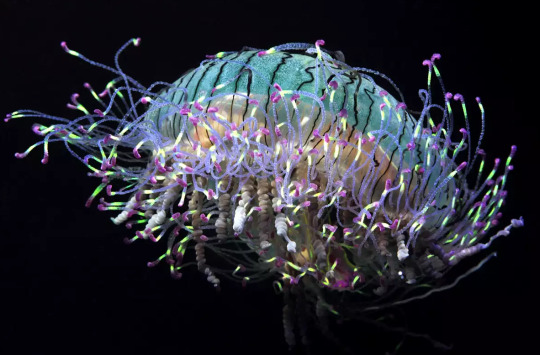
The flower hat jelly, scientific name Olindias formosus, is a small and rare jelly known for the multicolored tentacles and luminescent display. Belonging to the hydrozoa family, the flower hat jelly is not actually a true jellyfish. The main difference between them being that true jellyfish belong to the Scyphozoa class, and have a life cycle defined by a longer period as a medusa (their adult form) whereas hydrozoans have a lifecycle primarily defined by their polyp or juvenile stages, sometimes even lacking medusa forms, a pattern that can once again be found in the flower hat jelly's life cycle. Their distribution is off the coastline of Japan, Korea, and countries within Oceania. Although some believe that these jelly's can also be found outside of Argentina, and Brazil, it is thought this may be a close relative, Olindias sambaquiensis. With a depth range from sea level down to 55m of depth, these jellyfish tend to live near the ocean floor where they can hide among kelps, sea grasses, and loose rocky bottoms.

Living a nocturnal life, the flower hat jelly spends its days hiding on the ocean floor. But, once dusk arrives this jelly rises from its hiding places to capture small fishes within its tentacles, paralyzing and or killing the fish, before drawing the corpse up into the bell to be consumed. The stings from this jelly are painful, and at least one fatality has been recorded from them in Japan. These tentacles hold most of the intrigue of the flower hat jelly. The length of the tentacles may appear to be random, but has been found to be arranged mathematically in an optimization hashing algorithm known as fibonacci hashing. Length aside however, these jelly's, and especially their tentacles contain fluorescent proteins, which are used to attract prey when hunting, and are particularly bright under blacklight. This protein is uniquely interesting due to its use in helping treat some COVID cases, as it can be used as an inhibitor, stopping the replication of the disease, and slowing or halting its spread.

The reproduction and younger stages of the flower hat jellyfish were a mystery for many years, but in 2012 the Monterey Bay Aquarium managed to be the first to breed them in captivity, capturing a full lifecycle from larvae to polyp to medusa. Beginning as polyps attached to a hard surface along the seabed, where they are completely stationary, surviving off of a single active tentacle, which is waved back and forth to gather nutrients, forming a medusae and releasing them only once a size of 1mm was achieved. Then they will mature into juvenile medusa, which are identical to adult medusa in appearance and behavior, only being identifiable by their smaller size and less tentacles. Juvenile medusa only being around 2-20mm, and adults getting only as large as 6inches total throughout their lifespan. Adult flower hat jellies are only observed in the months of December-July with peaks in the months of May and April. However, we understand very little about how these jelly's sexually breed in the wild, but fertilization occurs externally, as gametes are released into the water to create small, non-cooperative colonies along similar areas. These animals live only 4-6 months as adults, and only around a year total before slowly losing their fluorescence and passing away.

That's the flower hat jelly, everybody, have a wonderful Tuesday!
#ish#fish of the day#fishblr#fishposting#aquatic biology#marine biology#freshwater#freshwater fish#animal facts#animal#animals#fishes#informative#education#aquatic#aquatic life#nature#river#ocean#fish#jellyfish#jelly#flower hat jelly#hydrozoan
136 notes
·
View notes
Text
Round 2.5 - Cnidaria - Staurozoa


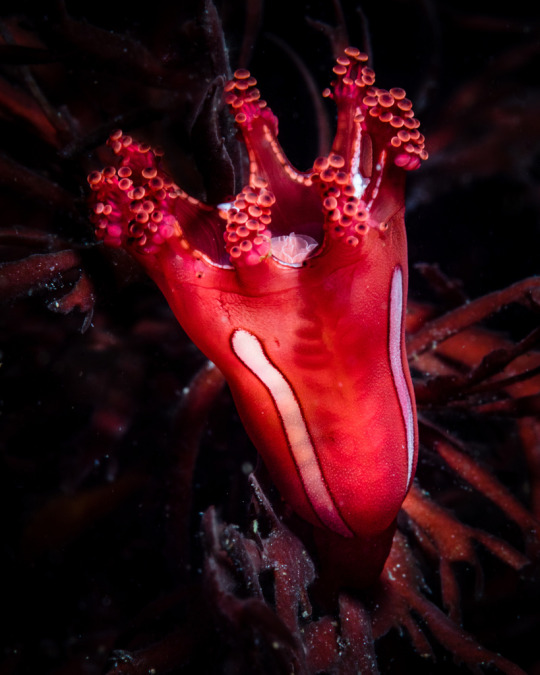

(Sources - 1, 2, 3, 4)
Staurozoa is a small class of Cnidarians consisting of just one extant order: Stauromedusae (“Stalked Jellyfishes”) with a total of 50 known species. They are unique among medusa jellyfish in that they do not have an alternation of polyp and medusa life cycle phases, but instead live as an attached medusa stage, with a lifestyle more resembling that of polypoid forms.
Staurozoans are small animals that live in marine environments, usually attached to seaweeds, rocks, or gravel. Their body consists of a calyx, or cup, where they take in their prey with tentacles that contain cnidocysts (stinging cells). They are umbrella-shaped, oriented upside-down in comparison with other jellyfish, with the tentacles projecting upwards or outwards, and a stalk located in the centre of the umbrella, attached to substrate with an adhesive basal disk. Staurozoans usually have eight marginal arms at the top of the calyx. They are predators, with a diet including crustaceans, chironomid fly larvae, and plankton. After digestion, they eject the remains of their food from their bodies. The color of the staurozoan depends on what they've attached to in their environment.
Little is known about the staurozoan life cycle. They have a lifespan of less than a year and the planula larva attaches to the substrate, developing into a primary (interstitial) polyp that undergoes an apical transformation to develop into its adult body. They reach their adult sizes within several weeks, typically 1 to 4 centimeters in length.
Information on Staurozoa is sparse, and it is one of the least studied groups within Cnidaria. Even so, we have fossil evidence of staurozoans dating back to the Late Ediacaran.
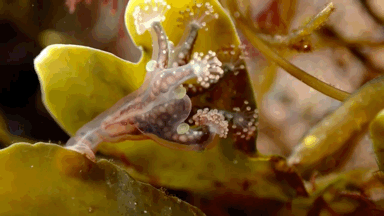
(source)
#no extra propaganda bcause i’m operating on very little sleep and one blink away from passing out goodnight#cnidaria#animal polls#round 2.5
72 notes
·
View notes
Text
🪼Daily Cnidarian Fact:🪼
Moon Jellyfish: These extraordinary lunar beauties go through many phases in their lives — from egg to polyp to "medusa" with a few steps in between. Although they didn't get to the moon, nearly 2,500 moon jelly polyps and ephyrae — two early stages in the jelly life cycle — went into orbit aboard the space shuttle Columbia in May 1991. They were part of a study on the effects of weightlessness on the development of internal organs in juvenile jellies.

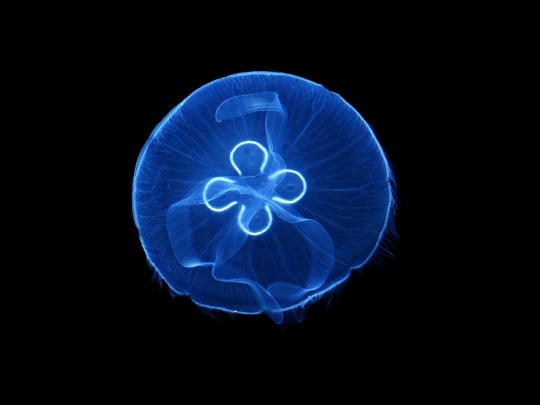
#moon jellyfish#moon jelly#jellyfish fact#daily jellyfish#daily jellyfish fact#facts about jellyfish#jellyfish post#jellyfish#respect the locals#cnidarian post#cnidarian fact#daily cnidarian#daily cnidarian fact#facts about cnidarians#cnidarian#marine animals#marine biology#marine life#marine life blog#marine life advocate#advocacy for marine life#marine#ocean#ocean life#ocean life blog#ocean animal
82 notes
·
View notes
Text
A biological take on phoenixes
Trophics and ecology
~ Not a single-member species, but relatively rare due to being essentially fifth-degree consumers
~ ~ Typically omnivorous, preferring rodents and other small animals
~ ~ Before hibernation, immolation, migration, or another energy-intensive phase of life, they will set fire to the nearest rich, burnable area and collect the “burn energy” by magical means yet poorly understood
~ ~ They can “eat” entire swaths of a given biome via burning
~ ~ ~ In these cases, phoenix consumption is on par with some dragons
~ ~ ~ Can be devastating, but desolation events are very rare
~ ~ ~ These burnings have had a significant influence on fire ecology and ecosystems’ adaptations to it. Many are more resilient to fire and other dramatic disturbances than phoenix-rare regions.
~ ~ A large, highly productive forest has the carrying capacity for only a dozen phoenixes or so; most biomes far fewer
~ Found on every continent and multiple islands
~ ~ Including Antarctica, with penguins
~ ~ Preference for grasslands, savanna, and other quick-recovering biomes
Reproduction
~ Contrary to popular belief, phoenixes don’t reproduce via self-immolation
~ ~ The fire renewal is more akin to a cnidarian returning to a polyp stage, rejuvenating cells and systems
~ ~ ~ Multiple studies have confirmed an individual retains memories both between fire-molts (misnomer stemming from early misunderstanding of the purpose of self-burning behaviors) and during them
~ ~ This would make the phoenix amortal if it weren’t for some other pesky buildups that ultimately give its lifespan a hard cap
~ ~ ~ Still, scientists theorize a phoenix could live somewhere between 800 and 2500 years in perfectly ideal circumstances
~ Pretty typical breeding adaptations
~ ~ Technically capable of breeding any time of year; the plurality will breed in spring or early summer, or else “sync up” with their host flock
~ ~ Two major breeding sites: one in southern hemisphere and one in northern
~ ~ ~ Phoenixes who pass anywhere near the island during family migration will feel a pull proportional to the current phoenix population on it, and many will be drawn to it
~ ~ ~ ~ (Phoenixes have strong navigation and homing capabilities, but this does occasionally lead to host group loss and reshuffling)
~ ~ During breeding season (or when Hot Single Firebirds in their area), both sexes will shed mimicry feathers and grow their signature fiery reds
~ ~ ~ Variety of shades and saturations
~ ~ ~ Males tend to have really showy feathers — long tails, fiery curling, yellows mixed in amid the reds
~ ~ ~ Females take on more of a brassy red
~ ~ ~ Have a variety of mating calls, movement displays, and semi-immolations
~ ~ ~ Courtship is brief
~ ~ ~ ~ Involves a huge range of behaviors as males prove their mettle
~ ~ ~ ~ Some of these displays are taken from other birds, and even dragons
~ ~ ~ Mates tend to practice single-season monogamy
~ ~ ~ ~ Lay about a dozen eggs over the course of the season
~ ~ ~ ~ Each egg is dropped off at a different nest
~ Engage in a kind of adaptive brood parasitism
~ ~ Identify what compels a given host parent to care for young
~ ~ Mimic that thing — feather color, body movement, sound, scent — phoenixes have a broad toolkit and can copy a lot
~ ~ They are master mimics and manipulators
~ ~ ~ Actually quite social, spending most of their time with family groups, resembling them in both appearance and behavior. Reputation for being solitary because it’s rare to see them in their distinct “rusted” form.
~ ~ Can brood parasitize a variety of species
~ ~ ~ Prefer birds of prey, corvids, and high intelligence generally
~ ~ ~ Form special mutualistic partnerships with firehawks (black kite, whistling kite, brown falcon) in which they hunt together
~ ~ ~ Become fairly contributing members of their adopted social groups, though they cause wider scale damage with their fire feeding.
~ ~ ~ Uncommonly spend time with each other, mostly to court and mate. Unlike cuckoos, this species does not really have much of a strong, teachable identity. Fire abilities and behaviors are instinctive; otherwise, each phoenix takes on the traits of its adopters.
Miscellaneous facts
~ ~ Feathers are selectively fire resistant, regardless of appearance
~ ~ ~ Certain times, types, and areas of feathers *are* flammable, and this seems to be to the animal’s benefit
~ ~ ~ Notably, the long ends of wingtip feathers are highly flammable — phoenixes probably light these and brush them against grasses to start hunting fires
~ ~ ~ (It is also unknown how phoenixes light themselves “on demand,” though studies into the chemical pathways are making inroads)
~ ~ Feathers do not perfectly mimic host species’ feathers in structure or color. They’re close enough to pass from far away, and adopted family members rarely seem to take issue. However, on close inspection, an expert in either bird species will have no trouble picking a phoenix out.
~ ~ ~ Inspired by that plant that can mimic other leaves and might be able to see
~ ~ It is theorized some phoenixes may be capable of a kind of parthenogenesis via “mitosis” of the “polyp” stage, but the mechanisms for this are unknown
~ ~ Phoenixes’ sheer range of adaptability suggests they have an enhanced ability for “genetic learning,” far beyond the typical influence of epigenetics. Offsprung individuals are well documented to display traits or behaviors learned by their parents — parents they have never met. This suggests phoenixes possess a yet-unknown means of knowledge transmission through bodily inheritance.
~ ~ Phoenixes also possess top-tier cognitive skills. They’ve displayed self-awareness, reasoning, and complex communication. Some researchers argue these things qualify phoenixes for personhood.
#phoenixes#phoenix#speculative evolution#sort of#worldbuilding#biology#birds#dragons#4444#fire ecology
24 notes
·
View notes
Text
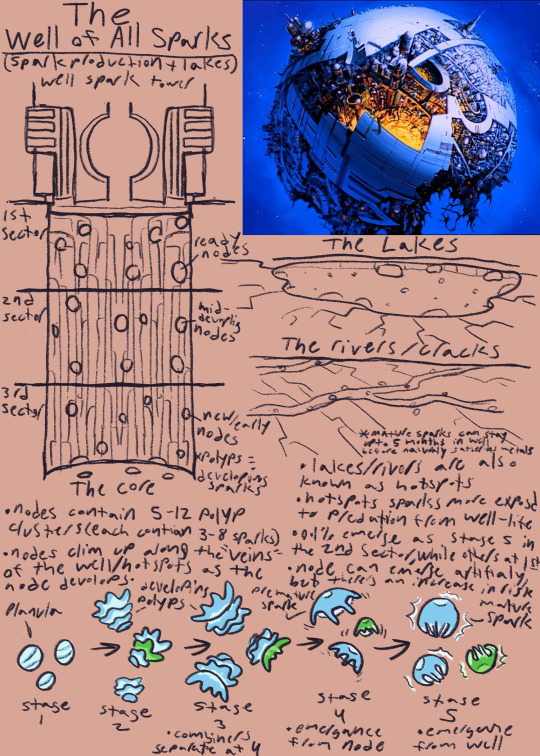
this is just my little version of The Well of All Sparks and it's production of new sparks.
I will be delving more into a bit as well as the lakes/rivers enviornment.
typed text below (for if my handwriting is unreadable)
it also goes into a little more detail about each stage :>
a Node commonly contains between 5-12 polyp clusters.
each cluster can contain 1-8 polyp sparks.
the Nodes slowly climb up the walls + veins of the Well (and hotspots) as the Nodes develop.
Nodes membranes get thinner the farther they develop and clime up; the membrane brakes when polyp sparks separate from their polyp clusters and finalize development.
lakes + rivers (cracks) are also classified as hotspots.
hotspot developing sparks/Nodes tend to be more exposed to outside factors and "marine" wildlife than the Well and contained hotspots.
the 0.1% (the green sparks) emerge as a stage 5 development in the 2nd sector level of the Well (or hotspots); while normal sparks will emerge as stage 5 out of the 1st sector.
Nodes and developing sparks can be removed artificially (as early as a 3rd sector in a stage 1), but they'll tend to be more at risk of becoming unstable.
mature-ready sparks can stay in the Well/hotspots for up to 5 months (the cybertronian equivalent) inside before it's forced to exit and start gathering any available metals to stabilize and further develop, or it'll get re-absorbed or eaten.
stage 1: sparks are classified as planula at this stage as they just start development within Nodes. they'll divide into small segments before entering stage 2.
stage 2: polyps (sparks) further develop and grow inside the Node and the segments then form a polyp cluster; this is where 0.1% sparks have a chance at being identified.
stage 3: developing polyp clusters continue to develop and grow, their inner-energy now starting to develop and the individual spark-polyps become livelier and start separating from the cluster (soon to be identified as sparks instead of polyps). combiner class sparks however will separate at stage 4 because their connection an important stage of development.
stage 4: spark polyps are now classified as pre-mature sparks since they are (usually) fully separated from the clusters and all have successfully emerged from the Node (the Node membrane being very thin; it'll get reabsorbed).
stage 5: the now mature sparks have fully developed their inner-energy, the outside becoming a protective "skin" around it. they are also ready to emerge from the Well/hotspots and either naturally develop a protoform or be put into a pre-made body. they will be seen either bobbing at the top of the Well or slowly floating around in the 1st sector.
:>
#world building#au#kinda#transformers#maccadam#applies to any version tbh#the well of all sparks#tf!hotspots#hotspots are more like rivers or lakes instead of a field in this#transformers sparks#spark development#yes i took heavy insparation from jellyfish development#there will be more#making them like research papers#tf idw#tf g1#i usually take heavier inspiration from these two
18 notes
·
View notes
Text

Lion's Mane Jellyfish (Cyanea capillata)
Family: Cyaneid Jellyfish Family (Cyaneidae)
IUCN Conservation Status: Unassessed
Named for its frilly "mane" made up of over 1,200 long, stinging tentacles, the Lion's Mane Jellyfish is among the largest known jellyfish species; while this viral image showing a diver next to a Lion's Mane Jellyfish has been edited to make the jellyfish appear far larger than it actually is, members of this species still dwarf most of their relatives, with a bell ("main body") diameter of over 2.4 meters (7.89 feet) and a tentacle length of as much as 30 meters (98.4 feet), making it one the longest animals on earth. Typically found near the surface in the Arctic, northern Atlantic and northern Pacific Ocean regions, Lion's Mane Jellyfishes, like all jellyfishes, lack brains, eyes, hearts or respiratory organs (instead exchanging gasses directly between the water around them and their extremely thin tissues,) and rely heavily on waves and ocean tides to travel, but are able to slowly propel themselves in a given direction by expanding the 8 bag-like lobes of their bodies to take in water and then forcing it out again to push themselves along (although they can also to some extent detect and react to their orientation and surroundings owing to a series of frilly sensory structures located around their body's rim, know as rhopalia.) Like most jellyfishes the long, trailing tentacles of a Lion's Mane Jellyfish are lined with touch-sensitive, harpoon-like cells called cnidocytes that fire venomous barbs into any animal that touches them, and after a tentacle has stung and ensnared suitable prey (mainly fish, large plankton and smaller jellyfishes) it is pulled back towards the body where the prey is passed through a mouth-like opening on the jellyfish's underside and into a simple body cavity where it is digested, with any indigestible matter, such as shells or bones, later being ejected from the body through the same opening it entered through. The life cycle of the Lion's Mane Jellyfish, like that of most jellyfishes, takes place in 4 distinct stages and seems highly elaborate compared to that of most animals; the bag-like adults that we typically think of as jellyfishes, known as medusas, are either male or female and reproduce sexually by releasing gametes into the water around them, and should these gametes meet they fuse and develop into tiny larvae. The larvae then settle onto a solid surface and develop into polyps (a second, immobile life stage resembling a sea anemone,) and each polyp then asexually reproduces several times, with genetically identical, slow-swimming young splitting off of its body as buds. Each of these asexually-produced individuals will then develop into a medusa, continuing the cycle and meaning that each single instance of sexual reproduction in Lion's Mane Jellyfishes produces multiple asexually-produced offspring. Despite their massive size medusas of this species only live for around a year, although their polyps, which only reproduce under ideal environmental conditions, may remain dormant for longer than this.
---------------------------------------------
Image Source: here
#Lion's Mane Jellyfish#jellyfish#jellyfishes#cnidarians#cnidarian#cnidology#animal#animals#zoology#invertebrate#invertebrates#marine biology#marine invertebrates#scyphozoa#wildlife#marine wildlife
180 notes
·
View notes
Text
hehehehehehe evil thots illegal thots here have bad babysitter Stan
CW: drinking
——————
Stanley watched his brother run full speed around the house. He sighed. He should have never given into the boy’s pleas for ice cream. Their parents were going to be gone overnight and had tasked Stanley with watching the seven year old Stanford. He recalled his pa’s warning before they left the house: “He’d better be asleep by eight, and eat his entire dinner and-“ blah blah blah. Stanley knew what he was doing. Christ they worried so much.
He was pulled from his thoughts when he heard a crash. He paled. “Sixer, I know you didn’t run into that fucking urn.” He stared hard at their grandmother’s ashes on the floor. “God… dammit. Okay.” He stood and grabbed the broom, muttering to himself. He was gonna get his ears boxed for this.
Stanford stepped back and rubbed his arm sheepishly. “Sorry Stanley, I was pretending to be a B-52 and-“
“Yeah, bud, I saw.” He sighed. “You need to calm down a little, you’re literally bouncin’ off the walls. In fact-“ he glanced up at the cat clock monotonously ticking away above the entrance to the kitchen. “I think it’s bedtime.” He considered ashes in the dustpan and grabbed a Tupperware, dumping them in while his brother whined at him.
“What?! That’s not fair, you get to stay up all night and watch tv!”
“Yeah, cuz I’m charge tonight, and Pa gave me specific instructions on what to do with you. I’m not getting my ass whooped because you wanna watch cartoons longer than normal. I’m already getting it because you spilled Grandma on the fuckin floor.” He wiped his hands off on his white shirt, grimacing at the dark smudges. Sorry Grandma.
Ford frowned. “But I’m not tired.”
Stanley frowned. Getting this kid in bed when he didn’t want to go was nearly impossible. Then he remembered his ma talking about giving them gin on her finger when they were babies to calm them down and put them to sleep. He wondered if beer would do the same. “Tell ya what, you can stay up with me, but you have to drink with me. You wanna be a man or whatever? Come on.” He grabbed a six pack he’d stolen from the local grocery store from the fridge and placed it on the coffee table imposingly. “Think you’re up for it?”
Stanford puffed out his chest in pride. “I can do it! I am a man!” He ran over to the couch and sat down, keeping his arms crossed.
Stanley threw some pajamas at him. “At least get cozy.”
Ford groaned and started taking off his clothes. Stanley found his eyes trailing over the boy’s soft body, coming to rest on the boy’s tighty whiteys. He shook his head when Stanford pulled his pj’s back on and flopped down onto the couch, cracking open a cold one with the boy. He grabbed the clicker and switched on the tv, flipping through channels until they hit some documentary and Sixer started yelling at his older brother to stop there so he could learn about jellyfish. Stanley groaned but figured the kid would only be up for a little longer so he obliged and settled back as he was lectured on the stages of jellyfish life, polyp stage, Medusa stage, blah blah blah. He sipped his beer boredly, and pulled the boy closer, offering him the bottle. “Here. You said you’d keep up with me.”
Stanford took it, a bit unsure of himself and sniffed it, recoiling a bit at the heavy fermented wheat smell. “You sure Pa won’t get mad?”
“Not if Pa doesn’t know. You gonna rat me out?”
“No.”
“Then shut up and quit worrying. Drink.” He opened another beer for himself and chugged half of it, letting out a loud long burp afterwards that sent Stanford into giggles.
“Gross Stanley!” He hit his arm and regarded the bottle before taking a tentative sip and almost spitting it out. Stanley covered his mouth.
“Swallow, Sixer.”
Ford swallowed with a shudder and let out a much smaller burp. Stanley grinned and nodded for him to keep going as the teen continued sipping his own beer. Stanford wasn’t going to back down from a challenge- he never did. So he drank. He finished the bottle about the same time that Stanley was half way through his second. He leaned back with a groan. His tummy hurt, but he didn’t feel drunk? At least, he didn’t think so?
“Hey kid, go grab those chips.” Stanley pointed to the bag of potato chips on the counter in the kitchen. “But finish this first.” He handed him the half full bottle of beer he had been working on. “Then we’ll be even.” He smirked, seeing the unsure look on Ford’s face. “Unless you’re chicken.”
Ford wrinkled his nose and tilted the bottle back, holding his breath to avoid tasting the sour liquid as it washed down his throat. He slammed the bottle down on the table, burped in his brother’s face, stood up determinedly, took one step towards the kitchen, and fell flat on his face with a groan.
Stanley burst out laughing and stood, stretching. “That was so easy. Alright, bed-“ his inebriated brain focused in on the lining of Ford’s underwear peeking out from his pajama pants. His cock jumped in his own sweats. He looked at the clock. He still had hours before their parents were home… and he and Ford had played before. It’s not like he hadn’t gotten a yes any other time he’d asked, why would this time be different. He picked the drunk kid up and tossed him on the couch.
Stanford grunted and blinked up at him. “Dizzy…”
“Shh.” He pulled the boy’s pants and underwear off, silent, and let Ford’s legs fall back onto the couch as he stared at the boy’s soft cock. He just… he needed this. He reached for another beer and took a drink of it before pushing it to his brother’s lips, making him take a drink despite Ford shaking his head. Stanley pushed Sixer back down onto the couch and pulled his cock out, stroking himself with a small groan before going down, taking Stanford’s entire package into his mouth and moving his tongue around, playing with his tiny cock and his fucking grape sized excuse for a sack. Ford let out a lewd noise, tangling small hands in his brother’s hair. “S-Stanleyyyy~” he crooned before his mouth fell open. He stared at the ceiling fan for what felt like a very long time as he focus’s on his brother’s warm mouth on his privates. He gasped- he was about to finish in his brother’s mouth when Stanley pulled off with a shimmery line of pre connecting his lips to Ford’s cock. He grabbed his brother’s legs and lifted them before spitting right onto his ass and shoving two finger into him. Ford yelped at the sudden penetration, wiggling clumsily in Stanley’s grasp but Stan had a big advantage on him in size and sobriety. “Easy buddy, I’m not gonna fuck you tonight, not really anyway. You get fingered and put to bed, that’s it.”
Ford let out an unintelligible whimpering slur of words at him that Stanley ignored as he felt around for Ford’s sweet spot. He found it quickly- he knew his way around- and didn’t let up on it, touching and feeling the boy’s prostate until Stanford came all over his own legs, blubbering and gasping. Stanley pulled his fingers out slowly and wiped them on the couch as he watched Ford catch his breath. “Are you ready for bed yet Sixer?”
Ford just closed his eyes and Stanley sighed in relief, curling around him in an apartment that was finally quiet.
36 notes
·
View notes